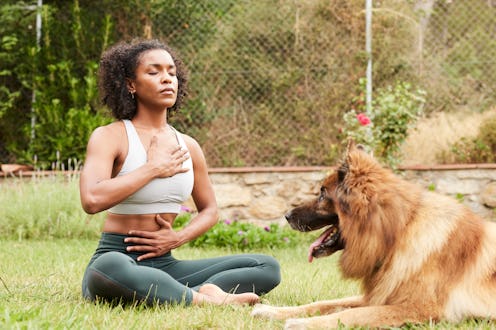Fitness
Lion's Pose Is One Of Yoga's Best Stress-Relievers
You'll have to get over how funny it looks.

Sometimes the best yoga poses are the ones that you’re a little shy to do in public. Think happy baby, a full-on savasana, or lion’s pose, aka that breathy exhale that involves rolling your eyes back into your head and sticking your tongue out. The latter posture feels rather silly, especially in the harsh light of day when you’re next to a perfect stranger in yoga class. But you should still do it — and there are so many reasons why.
Lion’s pose, also called lion’s breath, is a seated yoga posture that incorporates a breathing technique called pranayama, the yogic practice of focusing on your breath. In yoga, your breath works hand-in-hand with your poses, says Whitney Berger, a certified yoga instructor and founder of WhitFit NYC. Syncing your inhales and exhales with your flow helps you feel more connected and centered — so adding a big lion’s breath is like the cherry on top, especially if you’re tense.
“Forceful breath is a great way to relieve stress and anxiety,” Berger tells Bustle. The deep, open-mouth exhale you do in lion’s pose releases physical tension in your face, jaw, and neck, and it also releases emotional tension because, well, it’s kind of funny to let your tongue flop out. “Lion's breath is one of the most playful poses, and while it might look a little weird, it’s the perfect opportunity to just let go and not take yourself so seriously,” she adds.
Lion’s breath also does wonders for your throat chakra, says Rachel Hirsch, a yoga teacher and co-founder of Empowered Yoga. “This breath helps to open both the throat and thyroid, which are connected to communication, expression, and creativity,” she explains. “When open, you can express yourself freely, communicate your emotions — and truly find your voice.” Are you ready to embrace your inner lion? Here’s how to give lion’s pose a try.
How To Do Lion’s Pose
As Berger says, the more you get into this posture, the better it feels.
- Start by kneeling on a mat.
- Sit back on your heels and spread your knees wide.
- Place your hands on the ground in front of you.
- Position your hands so your fingers point backwards.
- Alternatively, let your hands rest on your knees.
- Lean forward slightly.
- Take a deep inhale.
- As you exhale, open your mouth wide and let your tongue hang out.
- Look ahead or up at your third eye center.
- Make a “ha” sound as you let out a long exhale.
- Inhale and repeat three to five times.
How To Modify Lion’s Pose
You don’t have to get into a full lion’s position to do lion’s breath. “I prefer sitting in a cross-legged position to do my lion’s breath,” Hirsch says. “I feel more grounded and in turn have more strength on my exhale. This can also be a great modification for anyone with tension in their knees, tightness through their legs, or weaker ankles.” It’s perfectly fine to take normal breaths between each lion’s breath, too, so that you don’t get lightheaded.
When Should You Do Lion’s Pose?
Lion’s pose can be added to any yoga routine. Many yoga classes end with a lion’s breath to release stress so that you head back into your day feeling refreshed. According to Hirsch, it’s also helpful on an as-needed basis, like when you’re anxious before a big meeting and need to get out bad energy or clear your throat so you’re ready to speak. Just like a lion, it’ll make you feel powerful, strong, and ready to roar. If you prefer to save this move for your at-home practice, that’s OK — your cat will surely enjoy watching you channel your inner feline.
Studies referenced:
Brown, RP. (2005). Sudarshan Kriya Yogic breathing in the treatment of stress, anxiety, and depression. Part II--clinical applications and guidelines. J Altern Complement Med. doi: 10.1089/acm.2005.11.711. PMID: 16131297.
Experts:
Whitney Berger, certified yoga instructor, founder of WhitFit NYC
Rachel Hirsch, yoga teacherl, co-founder of Empowered Yoga
This article was originally published on